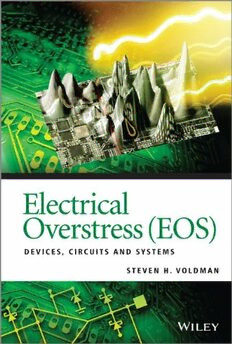
Electrical Overstress (EOS): Devices, Circuits and Systems PDF
Preview Electrical Overstress (EOS): Devices, Circuits and Systems
Red box Rules aRe foR pRoof stage only. delete befoRe final pRinting. Electrical VOLDMAN E Overstress (EOS) l e c t r DEVICES, CIRCUITS AND SYSTEMS i c a l STEVEN H. VOLDMAN, IEEE Fellow, Vermont, USA O Electrical Overstress (EOS) continues to impact semiconductor manufacturing, semiconductor components v and systems as technologies scale from micro- to nano-electronics. This book teaches the fundamentals of e electrical overstress and how to minimize and mitigate EOS failures. The text provides a clear picture of EOS r phenomena, EOS origins, EOS sources, EOS physics, EOS failure mechanisms, and EOS on-chip and system s design. It provides an illuminating insight into the sources of EOS in manufacturing, integration of on-chip, t and system level EOS protection networks, followed by examples in specific technologies, circuits, and r e chips. The book is unique in covering EOS manufacturing issues from on-chip design and electronic design s automation to factory-level EOS program management in today’s modern world. s ( Look inside for extensive coverage on: E Fundamentals of electrical overstress, from EOS physics, EOS time scales, safe operating area (SOA), O to physical models for EOS phenomena EOS sources in today’s semiconductor manufacturing environment, and EOS program management, S handling and EOS auditing processing to avoid EOS failures ) EOS failures in both semiconductor devices, circuits and systems Discussion of how to distinguish between EOS events and electrostatic discharge (ESD) events, such as the human body model (HBM), charged device model (CDM), cable discharge events (CDM), AD charged board events (CBE), to system level IEC 61000-4-2 test events NE DV Electrical EOS protection on-chip design practices and how they differ from ESD protection networks and solutions Discussion of EOS system level concerns in printed circuit boards (PCB) and manufacturing equipment SYICE Examples of EOS issues in state-of-the-art digital, analog and power technologies, including CMOS, SS T, LDMOS, and BCD E C EOS design rule checking (DRC), LVS, and ERC electronic design automation (EDA) and how it is MIR Overstress (EOS) S distinct from ESD EDA systems C U EOS testing and qualification techniques I T Practical off-chip ESD protection and system level solutions to provide more robust systems S Electrical Overstress (EOS): Devices, Circuits and Systems is a continuation of the author’s series of books on ESD protection. It is an essential reference and a useful insight into the issues that confront modern DEVICES, CIRCUITS AND SYSTEMS technology as we enter the nano-electronic era. STEVEN H. VOLDMAN ELECTRICAL OVERSTRESS (EOS) ESD Series By Steven H. Voldman ElectricalOverstress(EOS):Devices,CircuitsandSystems ISBN:9781118511886 September2013 ESDBasics:FromSemiconductorManufacturingtoProductUse ISBN:9780470979716 October2012 ESD:DesignandSynthesis ISBN:9780470685716 March2011 ESD:FailureMechanismsandModels ISBN:9780470511374 July2009 Latchup ISBN:9780470016428 December2007 ESD:RFTechnologyandCircuits ISBN:9780470847558 September2006 ESD:CircuitsandDevices ISBN:9780470847541 November2005 ESD:PhysicsandDevices ISBN:9780470847534 September2004 Upcomingtitles: ESD:TestandCharacterization TheESDHandbook ESD:AnalogCircuitsandDesign ELECTRICAL OVERSTRESS (EOS) Devices, Circuits and Systems Steven H. Voldman IEEE Fellow, Vermont, USA This edition first published 2014 # 2014 John Wiley & Sons, Ltd Registered office John Wiley & Sons Ltd, The Atrium, Southern Gate, Chichester, West Sussex, PO19 8SQ, United Kingdom For details of our global editorial offices, for customer services and for information about how to apply for permission to reuse the copyright material in this book please see our website at www.wiley.com. TherightoftheauthortobeidentifiedastheauthorofthisworkhasbeenassertedinaccordancewiththeCopyright, DesignsandPatentsAct1988. Allrightsreserved.Nopartofthispublicationmaybereproduced,storedinaretrievalsystem,ortransmitted,inany formorbyanymeans,electronic,mechanical,photocopying,recordingorotherwise,exceptaspermittedbytheUK Copyright,DesignsandPatentsAct1988,withoutthepriorpermissionofthepublisher. Wileyalsopublishesitsbooksinavarietyofelectronicformats. Somecontentthatappearsinprintmaynotbe availableinelectronicbooks. Designationsusedbycompaniestodistinguishtheirproductsareoftenclaimedastrademarks.Allbrandnamesand productnamesusedinthisbookaretradenames,servicemarks,trademarksorregisteredtrademarksoftheir respectiveowners.Thepublisherisnotassociatedwithanyproductorvendormentionedinthisbook. LimitofLiability/DisclaimerofWarranty:Whilethepublisherandauthorhaveusedtheirbesteffortsinpreparing thisbook,theymakenorepresentationsorwarrantieswithrespecttotheaccuracyorcompletenessofthecontentsof thisbookandspecificallydisclaimanyimpliedwarrantiesofmerchantabilityorfitnessforaparticularpurpose.Itis soldontheunderstandingthatthepublisherisnotengagedinrenderingprofessionalservicesandneitherthe publishernortheauthorshallbeliablefordamagesarisingherefrom.Ifprofessionaladviceorotherexpert assistanceisrequired,theservicesofacompetentprofessionalshouldbesought LibraryofCongressCataloging-in-PublicationData Voldman,StevenH. Electricaloverstress(EOS):devices,circuits,andsystems/StevenVoldman. pagescm Includesbibliographicalreferencesandindex. ISBN978-1-118-51188-6(hardback) 1. Semiconductors—Failures. 2. Semiconductors—Protection. 3. Transients(Electricity) 4. Overvoltage. I. Title. TK7871.852.V6482013 621.3815—dc23 2013022183 AcataloguerecordforthisbookisavailablefromtheBritishLibrary. ISBN:978-1-118-51188-6 Setin10/12ptTimesbyThomsonDigital,Noida,India. 1 2014 ToMyMother’sSister MyAunt Saundra “Sunny”Braitman Contents AbouttheAuthor xvii Preface xix Acknowledgements xxiii 1 FundamentalsofElectricalOverstress 1 1.1 ElectricalOverstress 2 1.1.1 TheCostofElectricalOverstress 2 1.1.2 ProductFieldReturns–ThePercentagethatisElectrical Overstress 2 1.1.3 ProductFieldReturns–NoDefectFoundversusElectrical Overstress 4 1.1.4 ProductFailures–FailuresinIntegratedCircuits 4 1.1.5 ClassificationofElectricalOverstressEvents 4 1.1.6 ElectricalOver-Current 6 1.1.7 ElectricalOver-Voltage 6 1.1.8 ElectricalOver-Power 7 1.2 De-MystifyingElectricalOverstress 7 1.2.1 ElectricalOverstressEvents 8 1.3 SourcesofElectricalOverstress 8 1.3.1 SourcesofElectricalOverstressinManufacturing Environment 8 1.3.2 SourcesofElectricalOverstressinProduction Environments 10 1.4 MisconceptionsofElectricalOverstress 10 1.5 MinimizationofElectricalOverstressSources 11 1.6 MitigationofElectricalOverstress 11 1.7 SignsofElectricalOverstressDamage 12 1.7.1 SignsofElectricalOverstressDamage–TheElectrical Signature 12 viii CONTENTS 1.7.2 SignsofElectricalOverstressDamage–TheVisual Signature 13 1.8 ElectricalOverstressandElectrostaticDischarge 14 1.8.1 ComparisonofHighandLowCurrentEOSversusESDEvents 15 1.8.2 ElectricalOverstressandElectrostaticDischargeDifferences 15 1.8.3 ElectricalOverstressandElectrostaticDischargeSimilarities 17 1.8.4 ComparisonofEOSversusESDWaveforms 18 1.8.5 ComparisonofEOSversusESDEventFailureDamage 19 1.9 ElectromagneticInterference 20 1.9.1 ElectricalOverstressInducedElectromagneticInterference 20 1.10 ElectromagneticCompatibility 21 1.11 ThermalOver-Stress 21 1.11.1 ElectricalOverstressandThermalOverstress 22 1.11.2 TemperatureDependentElectricalOverstress 22 1.11.3 ElectricalOverstressandMeltingTemperature 23 1.12 ReliabilityTechnologyScaling 23 1.12.1 ReliabilityTechnologyScalingandtheReliabilityBathtub Curve 23 1.12.2 TheShrinkingReliabilityDesignBox 24 1.12.3 TheShrinkingElectrostaticDischargeDesignBox 25 1.12.4 ApplicationVoltage,TriggerVoltage,andAbsolute MaximumVoltage 25 1.13 SafeOperatingArea 26 1.13.1 ElectricalSafeOperatingArea 26 1.13.2 ThermalSafeOperatingArea 27 1.13.3 TransientSafeOperatingArea 28 1.14 SummaryandClosingComments 28 References 29 2 FundamentalsofEOSModels 36 2.1 ThermalTimeConstants 36 2.1.1 TheThermalDiffusionTime 37 2.1.2 TheAdiabaticRegimeTimeConstant 38 2.1.3 TheThermalDiffusionRegimeTimeConstant 38 2.1.4 TheSteadyStateRegimeTimeConstant 39 2.2 PulseEventTimeConstants 39 2.2.1 TheESDHBMPulseTimeConstant 39 2.2.2 TheESDMMPulseTimeConstant 39 2.2.3 TheESDChargedDeviceModelPulseTimeConstant 40 2.2.4 TheESDPulseTimeConstant–TransmissionLinePulse 40 2.2.5 TheESDPulseTimeConstant–VeryFastTransmission LinePulse 41 2.2.6 TheIEC61000-4-2PulseTimeConstant 41 2.2.7 TheCableDischargeEventPulseTimeConstant 42
